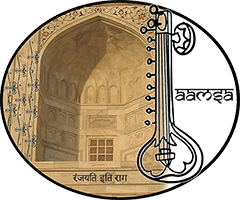Guidelines for Authors
The editors of Analytical Approaches to Music of South Asia (AAMSA) welcome submissions in the form of articles of moderate length (approximately 5000–12,000 words, including bibliography, notes, and appendices). We encourage submissions that take full advantage of our online format by including sound files, video clips, photos, animations, interactive examples and hyperlinks.
Submissions are subject to initial screening to ensure that they are consistent with the aims of the journal. Every suitable submission is then evaluated by two readers using a double-blind review procedure, such that the authors and readers do not know each others’ identities. If one reader recommends rejecting the submission and the other reader recommends acceptance, an evaluation by a third reader, or in some cases by the journal editors, is employed to break the tie. The review process typically lasts approximately four months; however, mitigating factors may increase or decrease this duration. Any manuscript that is accepted remains subject to editing for style and content, and the editors reserve the right to require substantial revisions prior to publication.
Submissions to AAMSA should consist of original research and should cite prior work appropriately. Authors are responsible for notifying the journal if they discover factual errors in the content of their work before or after publication.
Authors do not pay any fees to publish in AAMSA, and authors retain the copyright of individual articles and all associated media that they publish in the journal.
AAMSA is an open-access journal, meaning that the content is freely available to all users. Users may read, download, copy, distribute, print, search, or link to the full texts of the articles without requesting permission. The following conditions apply to distribution of articles in the journal:
- The author of the article and the name, volume, issue, and year of the journal must be identified clearly.
- No portion of the article, including audio, video, or other accompanying media, may be used for commercial purposes.
- No portion of the article or any of its accompanying media may be modified, transformed, built upon, sampled, remixed, or separated from the rest of the article.
Any exceptions to the above limitations require prior, written permission from the authors and advance notification of the journal editors.
AAMSA hosts all published material in the repository Zenodo to ensure the longevity and security of links to articles, DOI addresses, and supplementary files.
Submissions should conform to the following guidelines:
- Manuscripts submitted to AAMSA should not have been published elsewhere, nor should they simultaneously be under review or scheduled for publication in another journal, book, etc. Furthermore, if an author submits a paper to AAMSA that is based on material closely related to that in other published or submitted papers or books, the author should explain the relationships among them in a cover letter to the editors.
- All manuscripts and supporting files, as well as an abstract of 200 to 300 words and a list of 4 to 8 keywords, should be submitted electronically to managingeditor@southasia.iftawm.org.
- Manuscripts must be in English and should observe either United States or British conventions of usage, spelling, and punctuation.
- The AAMSA journal maintains the principles of gender-neutral discourse and the editors thus request authors and reviewers to adhere to these practices. AAWM has adopted a set of guidelines developed by the Society for Music Theory (SMT), which may be found at http://www.wmich.edu/mus-theo/nsl.html.
- Manuscripts must be submitted as MS Word files. All text should be double-spaced. The main body of the text should be typed in a 12-point font. Please leave 1″ margins on all sides, with only the left-hand margin justified. Authors should employ endnotes rather than footnotes.
- In order to maintain the integrity of the blind review process, authors should refrain from using any self-identifying information in any submitted files and documents. Acknowledgments should be presented in a separate paragraph following the main body of the text.
- All citations should employ the author-date system as set forth in Chapter 15 of The Chicago Manual of Style, 17th edition. For examples of the correct formatting of citations and bibliography entries, please refer to the “Author-Date” section of the Chicago-Style Citation Quick Guide and to recent issues of AAMSA.
- Any images or audiovisual examples that accompany the text must have a numbered title (e.g., Figure 1, Example 1, Video Example 1) and caption. In addition to including a title and caption, every example must also be referred to by its title in the body of the text (e.g., “As Figure 1 shows…,” “Example 1 demonstrates that…”).
- All graphical figures such as maps, photographs, music scores, software screenshots, and other visual material should be submitted in the text document. File names of separate graphics must match their figure number and caption in the text document (e.g., figure1_map_Africa.png, figure2_transcription_song1.jpg).
- If work is accepted for publication, contributors are responsible for obtaining permission to include any copyrighted material that falls outside the doctrine of fair use.
- AAMSA can accommodate most common media file formats, including MP3, WAV, AVI, MPG, MP4, WMV, MOV, etc. Authors should contact the editors regarding the use of other less common formats.
- Authors are encouraged to provide access to any unpublished audio or video recordings, numerical data, mathematical proofs, or other source materials that are cited as the basis for claims made in their articles. Such materials may be hosted by the journal, or by other online data repositories, as supplementary media or documents, or may be made available to interested readers by contacting the author.
